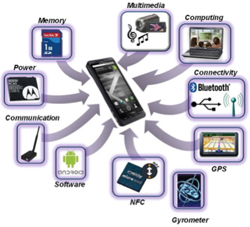 I have talked quite a bit over the last few years about how the trend towards small consumer devices with very fast ramp times. For example, pretty much any time Apple introduces a new product line (iPod, iPhone, iPad…) it becomes the fastest growing market in history. This has major implications for semiconductor design since the heart of these devices is semiconductors and software that runs inside them. The pace only keeps accelerating.
I have talked quite a bit over the last few years about how the trend towards small consumer devices with very fast ramp times. For example, pretty much any time Apple introduces a new product line (iPod, iPhone, iPad…) it becomes the fastest growing market in history. This has major implications for semiconductor design since the heart of these devices is semiconductors and software that runs inside them. The pace only keeps accelerating.
So what are the characteristics of this environment?
- semiconductor manufacturers have been very successful at delivering more technology, more performance, faster time to market, resulting in products that do more and in demand for…well, more
- lifestyles drive technology as customers want more connectivity, more performance, more integration
- the future is a convergence of digital, analog, memory, 3D packaging and software. Pure digital SoCs are less and less common since the real world is analog. 3D packaging (package-in-package, TSV etc) are coming important
- competitive markets with shorter and shorter product lifecycles
- design tools get more powerful, more integrated, take account of higher-level aspects of designs to drive productivity, and lower level aspects of design to guarantee functionality and yield.
 Magma’s Silicon One inititative is focused on making silicon profitable for their customers. It acknowledges that one EDA vendor cannot supply every tool required. Magma has five key technologies to address the main business challenges: time to market, product differentiation, cost, power and performance. Those five are Talus, Tekton, Titan, FineSim and Excalibur. These all work off a unified database for designing these complex chips that combine analog, digital, memory in a single chip.
Magma’s Silicon One inititative is focused on making silicon profitable for their customers. It acknowledges that one EDA vendor cannot supply every tool required. Magma has five key technologies to address the main business challenges: time to market, product differentiation, cost, power and performance. Those five are Talus, Tekton, Titan, FineSim and Excalibur. These all work off a unified database for designing these complex chips that combine analog, digital, memory in a single chip.
Like the parable of the blind men and the elephant, each feeling a different part, people view Magma differently depending on their experience. Some view Magma as industry leaders in the classical RTL to GDSII flow. others view Magma as having one of the most sophisticated analog/mixed-signal (AMS) solutions.
Both these groups may be surprised that Magma holds a strong position in the design of memory devices such as Flash, SRAM, DRAM and image sensors (yes, these aren’t technically memory but they are treated as so due to their attributes). Magma tools are used by the top 5 memory companies.
Perhaps more surprising is that Magma is a major player in yield management with a large installed base in amost every fab on the planet, but this is known mainly to just the customers who use this solution.
The Magma white paper on Silicon One is here.








Quantum Computing Technologies and Challenges